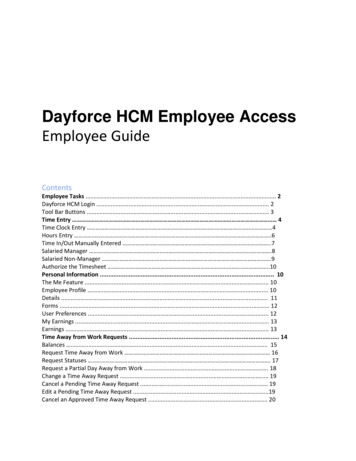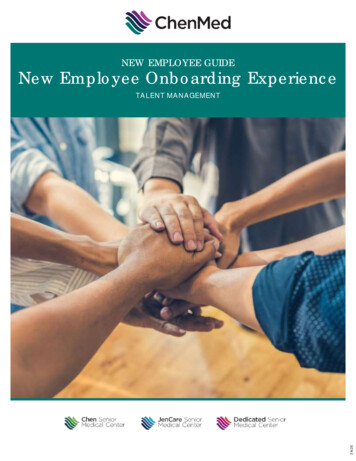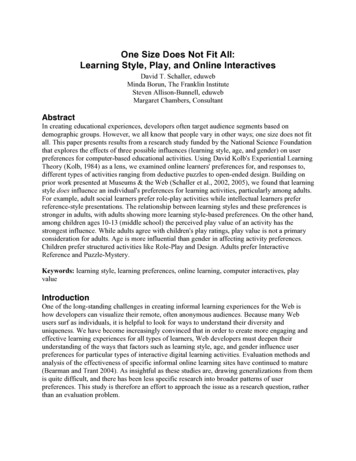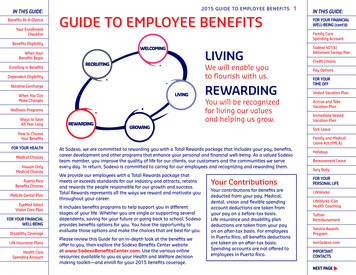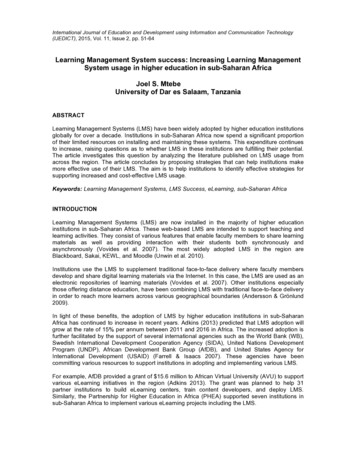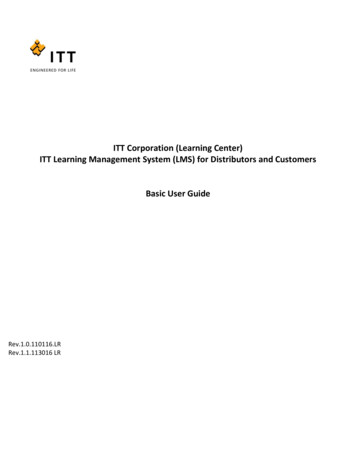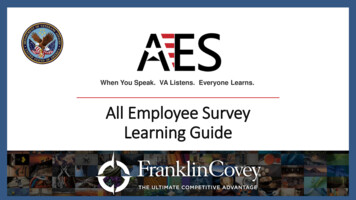
Transcription
When You Speak. VA Listens. Everyone Learns.All Employee SurveyLearning GuidePowered by the FranklinCovey All Access Pass 2020 FranklinCovey. All Rights Reserved.
How to use thislearning guide2 This guide contains a selection of on-demandAll Access Pass resources organized around eachof the ten All Employee Survey priorities. Thisguide include content from your Jhana website, 1indicated by the Jhana logo. If you aren’t able toaccess these resources, reach out tovacare@franklincovey.com for support. There are three focus areas for each priority,referred to as a ‘track’. A track is simply agrouping of content organized around a specificlearning focus. Each track is a complete, selfpaced learning experience, and it is not necessaryto complete them in order. 213 The text below each icon contains a deep linkto that specific learning item. When you click thelink, the learning item will open in your browser.(You may be asked to log-in to Jhana or the AllAccess Pass) 3 2020 FranklinCovey. All Rights Reserved.
How to use thislearning guide (cont.) Different icons represent variouslearning elements, including anestimated time to complete whereapplicable. If you need support accessing or usingthese resources, please contactvacare@franklincovey.com forassistance. You can explore more of whatFranklinCovey’s All Access Pass has tooffer here, on the VHA AAPInformation te self-paced,eLearning modules. Includesdownloadable tools anddiscussion questions.5-15-minute self-paced,eLearning modules. Includesdownloadable tools anddiscussion questions.FranklinCovey interviewswith a variety of thoughtleaders, authors, andprofessionals.Articles and Tips:Tools:Assessments:PDF documents to practiceand apply the skillsassociated with each track.Simple, PDF assessmentsto evaluate effectivenessin a variety of areas.Resources from Jhana withkey insights, tips, and shortvideos on a broad range ofmanagement challenges.20Video Discussion Activities:20–30-minute, video-based group discussions. Each of them includes facilitatorinstructions, debrief questions, and additional resources to enhance group learning. 2020 FranklinCovey. All Rights Reserved.
1Table of Contents Click on any of the AES Priorities to the right to view thetracks and learning resources that support it. Return to this table of contents at any time by clickingon the ‘AES’ logo in the top right corner of each prioritypage. 1 You can use this Learning Guide to: Learn by using the resources on your own Facilitate discussions in team meetings2 Assign elements to your learners in the All AccessPass Upload this document to SharePoint for easy accessand distribution.2 onInnovationCo-Worker RelationshipsEvaluationGoalsSupervisor RelationshipsFor Client Administrators: Click here to view a tutorial on assigning content within your AAP Portal Click here to view a tutorial on assigning external content in your AAP Portal 2020 FranklinCovey. All Rights Reserved.
CommunicationCommunicating necessary information timely and clearly.Focus Area Step ACKCEffectiveWritingThree, stand-alone learning experiences – 2 to 3 hours eachStep 2Step 3Step 4Step 5Step 630Seek First toUnderstand, Thento be Understood59 tips to listenlike a leaderDifficultconversationplanner530Leading EffectiveMeetingsThe HiddenStoryChecklist: How torun great remotemeetingsPlay YourChipsTemplates:Meeting agendaand follow-up30Writing forResultsAssess how wellyou write emailsHow to writeemails that passthe 10-second test6 strategies ofthe silvertongued515DiagnoseBefore YouPrescribeListening – ySession4 Types ofresistance inmeetings55Get YourVolume RightThe Secret toBusiness Writing(Crash Course –YouTube)Step 7Step 820Listening for Distance is hurtingmy team'sbetterapproachability communication20Running effectivemeetingsTeam can’t agreeor makedecisionsExplore more:Why business Meetingswriting is so awful Writing 2020 FranklinCovey. All Rights Reserved.
GrowthCreating opportunities for employee growth.Focus Area Step 1TRACKAGrowYourselfTRACKBGrowOthersTRACKCGrow theTeamThree, stand-alone learning experiences – 2 to 3 hours eachStep 2Step 3Step 4Step 5Step 630Paradigms andPrinciples ofEffectiveness55 ways to selfpromote (forthose who hateself-promotion)Assess yourown workmotivators530The MultiplierEffectExtraordinaryRoles6 simple ways toimprove yourcoachingconversationsLooking forGeniusdoing35EnergyCrisisBe Authentic, SeizeOpportunities, andMake an Impact5Coaching sessionevaluation30How to establishUnleash YourAssess how wellyourteam’s values –Team’s Potential you write emailsand why it’s worthThrough Coaching7Team building:Get to knowyour team35WoodenSee the potential allaround you: JaniceBryant Howard540Path toSynergyCrack YourCulture Code:Daniel CoyleStep 720Managing yourcareer when youwant to advanceStep 8Self-doubt holdingyou back? 4strategies toovercome it20Learning to buildother’s skills5 coachingquestions for whenyou’re tempted tojust tell someonewhat to doExplore more:How to Keep Your Individual GoalsTeam Motivated, CoachingRemotely Delegating 2020 FranklinCovey. All Rights Reserved.
WorkloadCreating opportunities for employee growth.Focus Area Step anagingDelegationThree, stand-alone learning experiences – 2 to 3 hours eachStep 2Step 3Step 4Step 5Step 6305Act on theDevelop questionsImportant, Don’tto determine theReact to the Urgent importance andurgency of tasksAvoid thePinballSyndromeHow toprocess emaileffectivelySchedule the Big Overwhelmed fromRocks, Don’t Sort working too muchthe GravelTechnology: Toolor Tyrant?30Workloadhandoff plannerAfter a direct reportcompletes adelegated project,assess how it wentFocus onYour Circleof Influence3509 tactics toassess how yourteam spends itstimeQ2 CultureI have to. I oughtto. I get to.Hyrum Smith540Extend TrustGreat LeadersClarifyExpectationsStep 820Karen Dillon onImprovingprioritizing what isProductivityDespitereally important inInterruptionsyour life5630Set Your TeamUp to GetResults7Step 7Too manyinterruptions20Improvingproductivitythrough blockingtime3 simplemanagementtactics to save yourteam’s time20Improvingproductivitythrough blockingtimeHave you falleninto the reversedelegation trapExplore more: Productivity Delegating 2020 FranklinCovey. All Rights Reserved.
AccountabilityHolding one another accountable for performance and professional conduct.Focus Area Step 1TRACKAHold MyselfAccountableTRACKBHold MyTeamAccountableTRACKCHold MyPeersAccountableThree, stand-alone learning experiences – 2 to 3 hours eachStep 2Step 3Step 4Step 5Step 630Habit 1: BeProactive7Do anaccountabilityself-assessmentthis weekAssess yourteam’s culture ofaccountabilityGreen and Clean30Think Win-WinIdentify and namean emotion that’sholding you back730Hold Regular1-on-1sYour Brainand BiasColleague outsidemy team won’thelpDeciding whichconversations toinitiate1-on-1 prep: For managers For directreportsStep 720538Discovery of aCharacterRaise YourAwareness: TashaEurich55520Examine YourReal MotivesOwn everythingthat impacts yourmission: Leif BabinManaging conflictwhen directreports don’t pulltheir weight540It TakesEveryoneAdd Value toPeople: JohnMaxwellStep 8Success is built onEstablishing‘yes’ and sustainedcredibility for twowith ‘no’way communication8 ways to increaseaccountability onyour team20Persuasion indotted-linerelationshipsHow can you gethelp from a teamthat doesn’treport to you?Explore more: Persuading ChallengingEmployees 2020 FranklinCovey. All Rights Reserved.
RecognitionRecognizing performance fairly and in a meaningful way.Focus Area Step kTRACKCFocus:ReceivingFeedbackThree, stand-alone learning experiences – 2 to 3 hours eachStep 2Step 3Step 4Step 5Step 630Create a Culture ofFeedback5 ways to build aculture offeedbackAssess yourteam’s feedbackculture425See the Tree,Not Just theSeedlingBlind SpotsPlanner: GiveeffectivefeedbackRadical Candor:Kim ScottHow to receivefeedbackI get defensiveabout feedbackSeeking feedbackfrom a hands-offmanagerTeam feedbackassessment20How much10 examples of howThe 5 languages ofreinforcingto give moreappreciation: Dr. feedback do I give?effective redirectingPaul Whitefeedback7Feedback logHow do you knowwhen to give feedbackto a direct report orwhen to let it go?385Make it Safe toTell the TruthWhole-PersonParadigmStep 82075Step 720Your Brain and BiasSeeking feedbackfrom direct reportsGiving feedback todefensive reportsConnect feedbackto team andorganizationalgoals12Confess yourmess: ScottMillerExplore more: GivingFeedback 2020 FranklinCovey. All Rights Reserved.
InnovationBeing willing and able to try new ideas in the workplace.Focus Area Step 1TRACKALead withCuriosityValueDifferencesTRACKC530Think Differently Stop! Don’t solve thatproblem just yet TRACKBThree, stand-alone learning experiences – 2 to 3 hours eachStep 2Step 3Step 4Step 5Step 6Create anInnovativeCulture30Look for GeniusUncoveringNeedsUse the “5 Whys”to get to the root ofa tough problemBring peopletogether withdivergent views andskillsetsMake ADebateFindStrugglingMomentsGet to know yourteamIdentify one smallinnovation to try and build onThe Three BiasTraps20Why criticism isgood for innovationStep 8720What we can learnfrom shortcuts?Team problemsolving20When someoneApathy is a Fierce shares a view or ideaCompetitor: Karen you disagree with,spend five minutesDillonassuming it’s true7Feedback logReframe a currentproblem as anexciting challenge3855Make it Safe toTell the Truth30Step 7Learning to buildother’s skillsGroupthink50Foster theSeeking feedback curiosity of yourfrom direct reports team to thrive:Explore more: InnovationDavid Epstein 2020 FranklinCovey. All Rights Reserved.
Co-Worker RelationshipsCooperating, collaborating, and treating one another with respect.Focus Area Step 1TRACKATRACKBBuildingEffectiveRelationships– Part 1BuildingEffectiveRelationships– Part 2TRACKCCreating aCulture ctionsThree, stand-alone learning experiences – 2 to 3 hours eachStep 2Step 3Step 4Step 5Step 620357BuildingRelationship Capitol6Emotional BankAccount302Synergize Collaboratingat the Speedof TrustExamine YourReal MotivesUnsure howpersonal toget at workStart WithHumilityMust work wellwith someone Idislike17Strengthen arelationship with acolleague who’swork impacts yoursIDEOAdd Value to People: 5 ways to kickJohn MaxwellstartStep 8How to makefriends at workconversations20Buildingrelationships fortwo-waycommunicationStep 7Repair arelationship505Achieve resultswith and throughother people:Todd DavisReconnectingwith disengageddirect reports20Better collaboration Getting help fromand idea generation other teams bybuildingrelationshipsToo busy tomaintainrelatiobships2Drivingcollaborationacross teamsExplore more: BuildingRelationships Collaboration 2020 FranklinCovey. All Rights Reserved.
EvaluationReflecting on our work through activities like huddles, after-action reviews, and/or debriefings.Focus Area Step 1TRACKATRACKBEvaluatingChangeEvaluating MySystems andProcessesTRACKCEvaluatingTasks andProjectsThree, stand-alone learning experiences – 2 to 3 hours eachStep 2Step 3Step 4Step 5Step 630Lead YourTeam ThroughChangeSelf-assessment:How well areyou leadingchange?30Align the SixRightsTrim Tab2Create a library of‘how-to’ documentsfor your team’s mostimportant workWorkloadhandoff plannerAsk each directreport to diagnosehow they’readapting to arecent change20Ensure YourManaging processSystems Support improvement froma strategic changeYour Mission30Monitor,Control, andClose Projects405After a direct reportcompletes adelegated project,assess how it wentStep 7Step 820Look Forward,Course correctingReflection GuideFaster: Mauro Guillé Managing yourand following– Adapting toresponse to changethroughChange1050Store 334Execute Your Wayto Engagement:Chris McChesney635TeamAccountabilitySessionBalance people andprocesses forsuccessful projects:Suzette BlakemoreSpend 30 minutes aweek and 10minutes a day onplanning20Explore more:I don’t knowProject Changemanagement withwhere my teammultiplestands on projectsstakeholders 2020 FranklinCovey. All Rights Reserved.
GoalsSetting of challenging and yet attainable performance goals.Focus Area Step 1TRACKATRACKBSettingIndividualGoalsSettingTeam GoalsThree, stand-alone learning experiences – 2 to 3 hours eachStep 2Step 3Step 4Step 5Step 630Go forExtraordinary,Don't Settle forOrdinary5Develop questionsto determine theimportance andurgency of tasksAvoid thePinballSyndrome630Create a Shared 5 types of strategicgoals that can helpTeam Visionyourteam performand StrategyApplying directreports work tocompany goalsbetterTRACKCAchievingGoals withExcellence30Disciplines 1 & 2to ExecuteStrategySMART goal andaction planSettingExpectationsChecklistHave your directreports publiclytrack goals5 ways toconnect directreports work totheir motivatorsStep 7745Play YourRoles WellWhat Do You Want?:Patrick Bet-DavidSetting andshaping keygoals61020OfferingBiggerChallengesSet Up Your Teamto Get ResultsSetting goals andvision for a team3040Disciplines 3 & 4to ExecuteStrategyWhy is it so hardto execute astrategy?Step 85 ways to help yourdirect reports setbetter goals20Explore more:How to lead yourCommunicating Goalsteam in pursuit of astrategy and Strategygoalsetting goals 2020 FranklinCovey. All Rights Reserved.
Supervisor RelationshipsFeeling comfortable with and supported by my supervisor.Focus Area Step 1TRACKACreatingPsychologicalSafetyThree, stand-alone learning experiences – 2 to 3 hours eachStep 2Step 3Step 4Step 5Step 62030Inspire a Culture Develop questions Building relationshipsto determine theof Trustwith defensive directimportance andurgency of tasksTRACKBManaging UpTRACKCNavigating
Templates: Meeting agenda and follow-up Team Accountability Session 5 4 Types of resistance in meetings 5 Running effective meetings 20 Team cant agree or make decisions Assess how well you write emails How to write emails that pass the 10-second test 6 strategies of the silver-tongued Get Your Volume Right 5 Why business writing is so awful The Secret to Business Writing (Crash Course .

